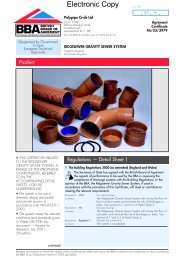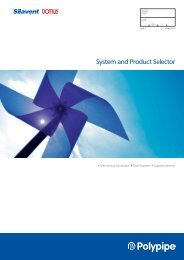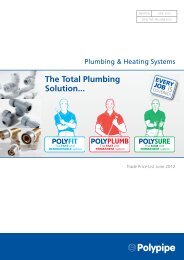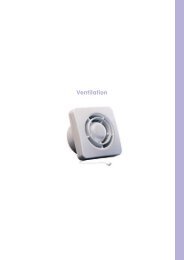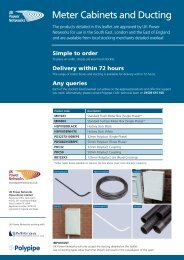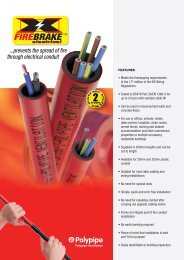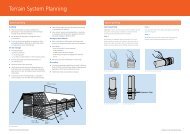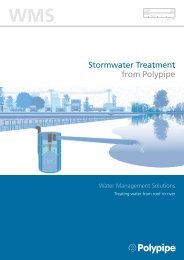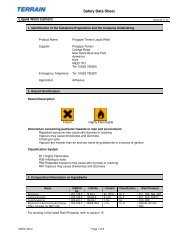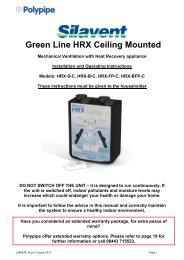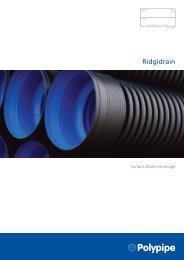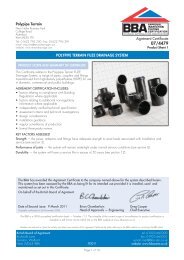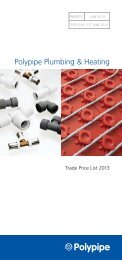Rodding Eye Details Inspection Chambers - Polypipe
Rodding Eye Details Inspection Chambers - Polypipe
Rodding Eye Details Inspection Chambers - Polypipe
- No tags were found...
Create successful ePaper yourself
Turn your PDF publications into a flip-book with our unique Google optimized e-Paper software.
<strong>Rodding</strong> <strong>Eye</strong> <strong>Details</strong><br />
<strong>Inspection</strong> <strong>Chambers</strong><br />
1
Deep <strong>Inspection</strong> <strong>Chambers</strong><br />
BS7158:2001<br />
Installation Procedures<br />
1. Excavate to the required depth for the <strong>Polypipe</strong> Non Man Entry<br />
Deep <strong>Inspection</strong> Chamber system allowing for space around the<br />
unit to work in.<br />
2. Install the chamber base unit on at least 100mm of granular<br />
material.<br />
3. Connect up all pipe work connections to the base using the<br />
recommended procedure for ring seal and Polysewer structured<br />
wall pipes.<br />
4. Backfill using as dug or granular material up to a point just<br />
below the top of the base unit allowing room to connect the<br />
next riser section.<br />
5. Ensure both the base riser sections are all clean and free from<br />
any dirt and debris and using the riser sealing ring (UG488)<br />
connect riser sections (available in 215, 415, 830 and 1740mm<br />
sections) together. Refer to Product Selection Guide for riser<br />
requirements.<br />
6. All riser sealing rings and riser sockets should be lubricated<br />
before installation.<br />
7. Use the FRK503 fixing kit to secure riser sections together in<br />
three equi-spaced positions.<br />
8. Continue to backfill just below finished ground level.<br />
9. Lubricate the frame seal and install to the required depth and<br />
angle. The ICDC1 sealed polypropylene cover and frame allows<br />
90mm telescopic adjustment and 10° angular adjustment and<br />
has a reduced diameter of 350mm in accordance with Approved<br />
Document H to the Building Regulations 2000 (see also BS EN<br />
752).<br />
10. Ensure that all four screws in the cover and frame are screwed<br />
down.<br />
11. Use the frame to riser fixing kit, FRK502 to fix the frame to the<br />
riser in four positions.<br />
12. If installing in a driveway a concrete surround should be<br />
installed around the frame to a depth of 225mm and width of<br />
300mm to provide support to the cover and frame.<br />
3
Riser to Riser and Riser to Frame Fixing Kits<br />
Test Procedure<br />
Testing should be carried out in accordance with BS EN 1610, as follows:<br />
1. Remove the cover from the chamber.<br />
2. Connect drain rods together to reach the required depth complete with a double worm attachment on<br />
the end.<br />
3. By opening the Schrader valve and applying pressure remove as much air as possible from the test bag.<br />
4. Wind the neck of the test bag into the double worm attachment until it is secure within the attachment.<br />
5. Ensuring that the valved end of the hose does not fall down the chamber, lower the bag down the<br />
chamber and into the channel section of the pipeline to be tested. The bag should be inserted down the<br />
pipeline as far as possible using the channel section as a guider.<br />
6. It is advisable to leave the rod attached until such time as the bag is inflated. This will assist in keeping<br />
the bag in position. Use a bicycle pump to inflate the bag observing the manufacturers maximum<br />
pressure recommendations.<br />
7. Once the bag has been inflated and a steel drain plug and manometer is in place at the other end of the<br />
pipeline the air test can be applied in accordance with BS EN 1610.<br />
8. Once the air test is complete remove the bag by connecting the double worm attachment, using the hose<br />
as a guider down the chamber. Remove as much air as possible from the bag and use the rod/double<br />
worm attachment to free the bag from the pipeline. Remove all test equipment from the chamber.<br />
4
Product Selection Guide<br />
Base<br />
code<br />
ICDB1,<br />
ICDB2<br />
or ICDB3<br />
depth (mm)<br />
1300140016001800200022002500260029003100330035003800<br />
1 1 1 1 1 1 1 1 1 1 1 1 1<br />
1 Riser - 215mm ICDR1 1 1 1 1 1 1 1<br />
2 Riser - 430mm ICDR2 1 1 1 1 1 1<br />
4 Riser - 860mm ICDR4 1 1 1 1 1 1<br />
8 Riser - 1720mm ICDR8 1 1 1 1 1 1<br />
Sealing Rings UG488 1 1 2 1 2 2 3 1 2 2 3 2 3<br />
Riser Fixing Kits FRK503 1 1 2 1 2 2 3 1 2 2 3 2 3<br />
Cover & Frame ICDC1 1 1 1 1 1 1 1 1 1 1 1 1 1<br />
Frame Fixing Kits FRK502 1 1 1 1 1 1 1 1 1 1 1 1 1<br />
The ICDC1 Cover and Frame also allows 90mm telescopic adjustment and 10° angular adjustment.<br />
Covers and Frames<br />
It is important to select a cover and frame with a suitable load classification for the location of the chamber. L<br />
classifications are as follows:<br />
(A) Equivalent to Class A15 load category of BS EN 124:1994 (Pedestrians and Pedal Cyclists only)<br />
(A+) Tested to withstand 35Kn test load (Light vehicular traffic on domestic drives)<br />
(C) = Tested to withstand 10Kn test load (non-vehicular traffic only)<br />
320mm dia. Covers & Frames<br />
UG439 Circular Concrete Cover & PP Frame (C)<br />
UG499 Circular Concrete Cover & PP Frame (C)<br />
UG436 Aluminium Sealed Cover & Frame (C)<br />
UG501 Circular PVC Sealed Cover & Frame (C)<br />
UG502 Square PVC Sealed Cover & Frame (C)<br />
460mm dia. Covers & Frames<br />
UG497 Circular Concrete Cover & PP Frame (A)<br />
UG419 Cast Iron Cover & Frame (A)<br />
UG444 Cast Iron Cover & PP Frame (A)<br />
UG511 Circular PP Cover & Frame (A+)<br />
UG512 Square PP Sealed Cover & Frame (A+)<br />
Where a heavier duty cover is required, UDC700 (320mm) and UDC750 (460mm) ductile iron covers and<br />
frames are available to BS EN 124/B125 tested to wisthand 125Kn test loads.<br />
URP720 (320mm) and URP760 (460mm) galvanised steel recessed pavior covers are available which will<br />
withstand a 100Kn test load.<br />
Covers for Internal Use<br />
The current Building Regulations do not require that internal inspection chambers have a double seal cover.<br />
Consequently, any of the sealed covers detailed above are suitable for internal use.<br />
5
Backdrop Manholes & Yard Gullies<br />
1. Internal Backdrop Manhole Detail<br />
2. Yard Gully Detail<br />
6



